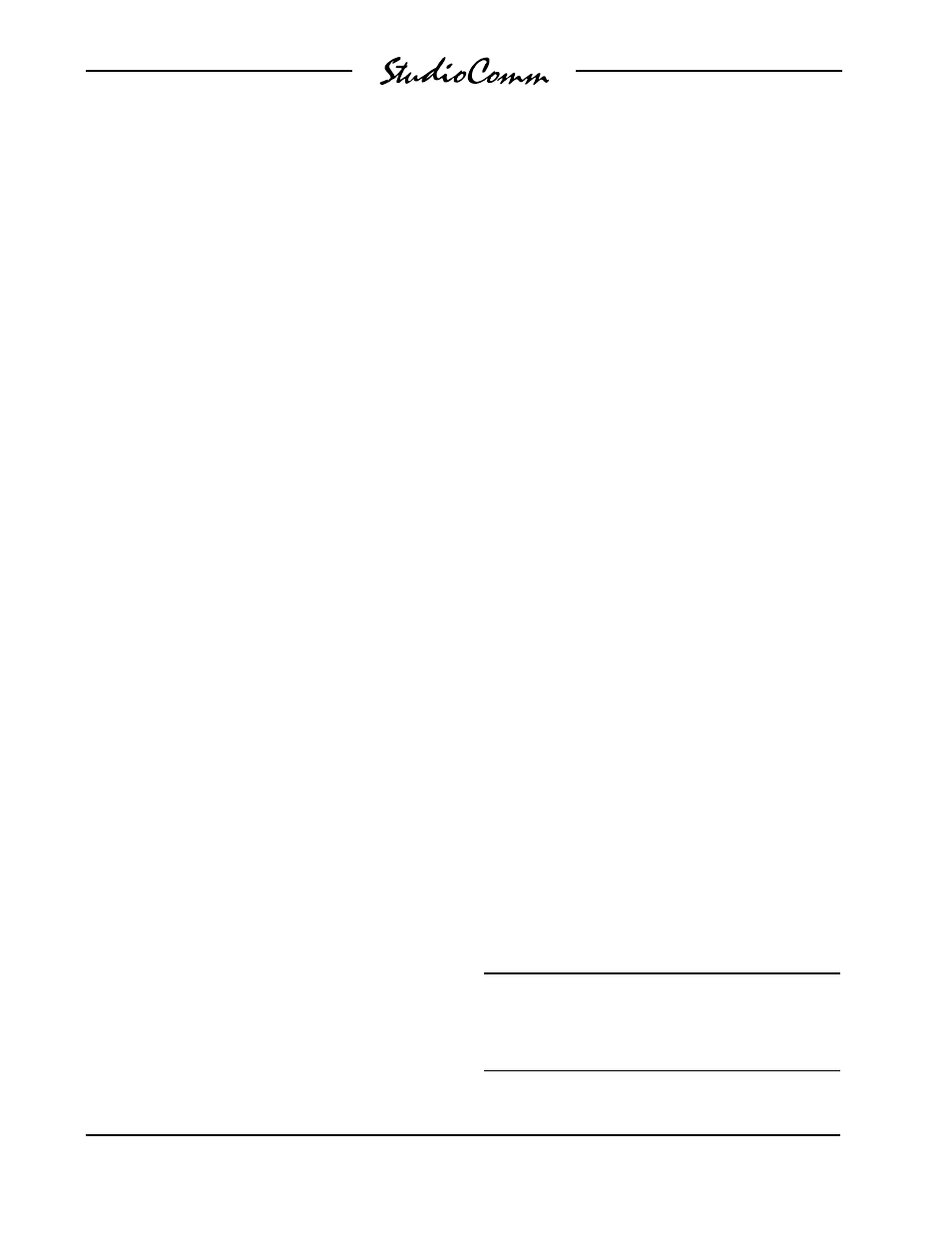Studio Technologies 78 2004 User Manual
Page 34

Issue 5, January 2004
Model 78/79 User Guide
Page 34
Studio Technologies, Inc.
for Surround
should be lifted straight up out of their
sockets. If SIP resistors are to be used to
achieve the revised frequency, they can
be directly inserted into the sockets. Pin
1 of the SIP resistors should correspond
with pin 1 of the sockets. Pin 1 is clearly
marked by means of a white dot on the
printed circuit board.
If three 1%-tolerance resistors are to be
used they must first be prepared for inser-
tion. To begin, one lead of each of the re-
sistors must be folded over (carefully bent
180 degrees) so that it becomes parallel
with the other. Then both leads must be
trimmed (cut) so that they extend out from
the body of the resistor by about ¼ inch
(6 mm). Once this has been completed the
resistors can be inserted into the sockets,
with three going into each. The first resis-
tor is inserted into socket pins 1 and 2, the
second into pins 3 and 4, and the third into
pins 5 and 6. After the resistors are insert-
ed, ensure that they are positioned so that
they stand straight up, safely away from
other components.
Main Input Low-Pass Filters
Each of the seven main input channels
(L, R, C, SL, SR, BL, and BR) also has
individual low-pass filter sections associat-
ed with them. Components were selected
at the factory so that the filter section’s
output has a –3 dB point of nominally
80 Hz. (The actual calculations work out
to be 82 Hz.) As with the high-pass filter
sections, each of the seven low-pass filters
can be configured independently. As the
previous example noted, it’s quite reason-
able that the L, C, and R channels utilize
one frequency while the other channels
use another. It’s also reasonable that each
input channel’s low-pass frequency be
configured differently from its associated
high-pass filter frequency. Using asymmetri-
cal filter settings can be very effective in
achieving the desired loudspeaker system
performance.
The frequency of each low-pass filter sec-
tion is configured by means of two ¼-watt,
1%-tolerance resistors, each identical in val-
ue. One 6-pin socket, located on the printed
circuit board, is used to hold the resistors.
From the factory, two 13.7 k (13,700) ohm
resistors are used to configure the filters for
nominally 80 Hz. To revise the frequency,
these can be replaced with two other resis-
tors, or a 6-pin isolated SIP resistor.
A simple formula is used determine the
resistance required for a specific filter
frequency: R = 1,125,400 ÷ F, where R is
resistance in ohms and F is frequency in
hertz. Figure 8 lists several frequencies that
are created using 1%-tolerance and SIP re-
sistors. As may be evident, the frequencies
were selected to roughly match the high-
pass filter frequencies shown in Figure 7.
The process required to actually change the
resistors is basically the same as with the
high-pass filter sections. The two factory-
installed 13.7 k resistors should be carefully
removed by using a pair of needle-nose
pliers. If two individual resistors are to be
used, they must be prepared for insertion.
The first resistor is inserted into socket pins
1 and 2, the second into pins 3 and 4. After
the resistors are inserted, ensure that they
are positioned so that they stand straight up,
safely away from other components.
150 Hz: 7.50 k
68 Hz: 16.5 k
124 Hz: 9.09 k
57 Hz: 19.6 k
113 Hz: 10.0 k
48 Hz: 23.7 k
102 Hz: 11.0 k
40 Hz: 28.0 k
82 Hz: 13.7 k
33 Hz: 34.0 k
Figure 8. Low-Pass Filters, Frequency versus
1%-Tolerance Resistor Value